Colombian coffee is well known for its distinct and complex flavor profile, which varies depending on the region where it’s grown. The country’s diverse geography and ideal growing conditions contribute to tghe Colombian coffee flavor profile of some of the finest coffee beans in the world.
Coffee-Growing Regions in Colombia
Colombia’s coffee-growing regions are spread across the country’s mountainous terrain, each offering its own unique characteristics:
Antioquia
Located in the northwest, Antioquia produces coffee with a balanced flavor profile. The beans from this region often have a medium body with notes of chocolate and caramel.
Huila
Situated in the south, Huila is known for producing coffee with a bright acidity and fruity notes. The beans from this region often have flavors of red berries and citrus.
Nariño
In the southwest, Nariño’s high-altitude farms produce coffee with a complex flavor profile. These beans typically have a full body with notes of chocolate and nuts, accompanied by a wine-like acidity.
Tolima
Located in the central region, Tolima produces coffee with a balanced flavor profile. The beans from this area often have a medium body with notes of caramel and citrus.
What is Colombian Coffee?
Colombian coffee refers to coffee grown in Colombia, primarily from Arabica beans. The country’s coffee industry is known for its high standards of quality control and sustainable farming practices.
The Colombian Coffee Growers Federation (FNC) plays a role in maintaining these standards and promoting Colombian coffee globally.
What Does Colombian Coffee Taste Like?
Colombian coffee is celebrated for its well-rounded flavor profile. It typically offers a perfect balance of acidity and sweetness, with a medium to full body.
The taste often includes notes of chocolate, nuts, and caramel, complemented by fruity or floral undertones.
Some coffee drinkers describe the flavor as clean and bright, with a smooth finish.
Why is Colombian Coffee Considered the Gold Standard?
Colombian coffee is often considered the gold standard for several reasons:
- Consistent Quality: The FNC’s strict quality control measures confirm that Colombian coffee maintains a high standard of excellence.
- Ideal Growing Conditions: Colombia’s mountainous terrain, rich soil, and favorable climate create perfect conditions for growing high-quality coffee beans.
- Sustainable Practices: Many Colombian coffee farms use environmentally friendly and socially responsible farming methods.
- Distinctive Flavor Profile: The balanced and complex flavor of Colombian coffee appeals to a wide range of coffee drinkers.
- Rich Coffee Culture: Colombia has a long history of coffee production, with generations of farmers perfecting their craft.
PureCoffeeCraft is a participant in the Amazon Services LLC Associate Program, an affiliate advertising program created for sites to earn fees by advertising and linking to Amazon. If you are making a purchase at Amazon today, please click on one of my links. There is no extra cost for consumers who purchase from links.
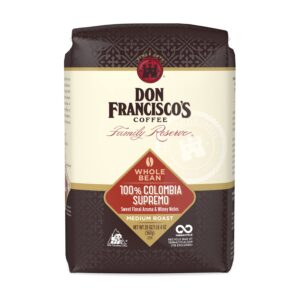
Colombian Coffee Product Reviews
Let’s take a closer look at some popular Colombian coffee products:
Don Francisco’s Premium Colombia Supremo Whole Bean Coffee
This medium roast coffee offers a rich and aromatic experience. Made from 100% Arabica beans, it features floral notes and a winey flavor.
These whole coffee beans will have a floral and sweet aroma with wine notes. when ground fresh for your morning coffee.
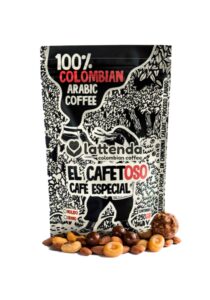
Lattenda Cafetoso Magic: Colombian Arabica Coffee
This specialty single-origin coffee boasts sweet notes and a cocoa aroma. Available as whole beans in a 250g package, it’s perfect for those who prefer to grind their coffee fresh.
This coffee brand is sourced from the beautiful Urrao mouintains in Colombia.
Madre Selva Colombian Chioso Bourbon Medium Roast
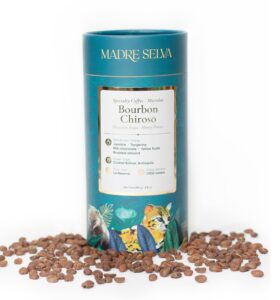
This medium roast, whole bean Colombian Geisha specialty coffee is a gourmet option for coffee enthusiasts. It has tasting notes of jazmine, tangarine, chocolate, fruits and roasted almond. The growing farms use sustainability processes that are environmentally friendly.
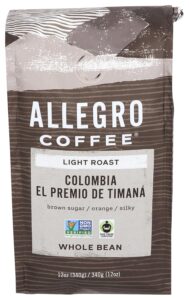
Allegro Coffee, Colombia El Premio De Timana
Available as whole beans in a 12-ounce package, this coffee has received positive reviews from customers. It’s a great option for those looking to explore Colombian coffee flavors.
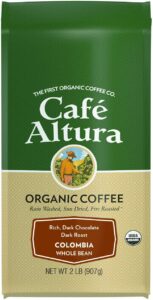
Cafe Altura Whole Bean Organic Coffee, Colombian
This organic coffee comes in a 2-pound package of whole beans. It’s a good choice for those who prefer organic products and want to enjoy the full flavor of Colombian coffee.
This is dark roast coffee with a rich, dark chocolate taste.
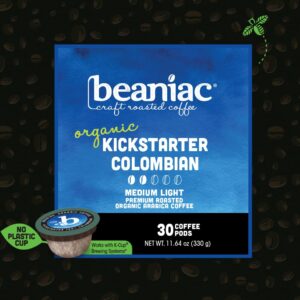
Beaniac Organic Kickstarter Colombian Pods
For those who prefer the convenience of single-serve pods, this medium-light roast coffee is available in compostable K-Cup pods. It’s compatible with Keurig brewers and offers an organic option for Colombian coffee lovers.
This beaniac coffee is also Rainforest Alliance Certified and 100% Arabica bean coffee, giving it a rich flavor profile and consistent quality. It is a favorite among coffee drinkers worldwide.
Whether you prefer whole beans, ground coffee, or single-serve pods, there’s a Colombian coffee product to suit your taste and brewing preferences.
Flavor Profiles and Coffee Tasting: Appreciating Complexity
Coffee tasting, much like wine tasting, is an art that involves understanding and appreciating the complex flavor profiles and aromas present in each cup. By learning to identify different flavor notes and characteristics, you can enhance your coffee-drinking experience and develop a deeper appreciation for the nuances of various coffee origins, including the beloved Colombian coffee.
Understanding Coffee Flavor Profiles
A coffee’s flavor profile is a combination of its taste, aroma, and mouthfeel. These elements are influenced by factors such as the coffee’s origin, growing conditions, processing methods, and roasting level.
Let’s break down the key components of a coffee flavor profile:
Acidity
Acidity in coffee refers to the bright, tangy quality that adds liveliness to the cup. It’s often described as:
- Crisp
- Bright
- Vibrant
- Sparkling
Colombian coffee is known for its bright, pleasant acidity, which contributes to its clean and refreshing taste.
Body
The body of coffee refers to its weight and texture in the mouth. It can be described as:
- Light
- Medium
- Full
Colombian coffee typically has a medium to full body, giving it a satisfying mouthfeel.
Flavor Notes
Coffee can have a wide range of flavor notes, often categorized into:
- Fruity (berries, citrus, stone fruits)
- Nutty (almonds, hazelnuts)
- Chocolatey (cocoa, dark chocolate)
- Caramel or brown sugar
- Floral (jasmine, rose)
- Spicy (cinnamon, clove)
Colombian coffee often features a combination of chocolate, nut, and fruit notes, creating a well-balanced and complex flavor profile.
The Coffee Tasting Process
To fully appreciate the flavor profile of coffee, follow these steps:
- Smell the coffee: Before tasting, inhale deeply to appreciate the aroma.
- Slurp the coffee: Take a small sip and slurp it to spread it across your palate.
- Let it coat your mouth: Allow the coffee to sit in your mouth for a moment.
- Identify flavors: Try to pick out specific taste notes and characteristics.
- Consider the aftertaste: Pay attention to the lingering flavors after swallowing.
Coffee Flavor Profile Chart
Here’s a simple chart to help you identify and describe coffee flavors:
| Category | Flavor Notes |
|---|---|
| Fruity | Apple, Berry, Citrus, Cherry |
| Nutty | Almond, Hazelnut, Peanut |
| Chocolatey | Cocoa, Dark Chocolate, Milk Chocolate |
| Sweet | Caramel, Brown Sugar, Honey |
| Floral | Jasmine, Rose, Lavender |
Appreciating Colombian Coffee
When tasting Colombian coffee, pay attention to its distinctive characteristics:
- Balanced flavor: Notice how the acidity, sweetness, and bitterness work together.
- Bright acidity: Appreciate the crisp, clean quality that adds liveliness to the cup.
- Chocolate and nut notes: Look for flavors reminiscent of cocoa or various nuts.
- Fruity undertones: Try to identify subtle hints of berries or citrus.
- Smooth finish: Notice how the flavors linger pleasantly after swallowing.
Popular Colombian Coffee Names
Some well-known Colombian coffee brands and varieties include:
- Juan Valdez
- Buendía
- Café de Colombia
- Supremo
- Excelso
- Medellín
- Huila
- Nariño
These names often represent specific regions or quality grades of Colombian coffee.
Exploring Coffee Flavor Profiles
To truly appreciate the unique qualities of Colombian coffee, it’s helpful to compare it with coffees from other regions. Here’s a brief comparison:
- Ethiopian coffee: Often features floral and fruity notes with a lighter body.
- Brazilian coffee: Typically has a nuttier flavor with low acidity and a heavier body.
- Kenyan coffee: Known for its bright acidity and wine-like qualities.
- Guatemalan coffee: Often has a chocolatey flavor with medium acidity and body.
By exploring these different flavor profiles, you can develop a deeper appreciation for the balanced and complex nature of Colombian coffee.
Understanding coffee flavor profiles and learning to taste coffee mindfully can greatly enhance your coffee-drinking experience.
Versatility in Brewing Methods
Colombian coffee’s adaptability to different brewing methods is another aspect that users appreciate. Here’s how it performs across various brewing techniques:
French Press
The full-bodied nature of Colombian coffee shines in a French press, producing a rich, robust cup with a smooth mouthfeel.
Pour-Over
This method highlights the coffee’s bright acidity and complex flavor notes, resulting in a clean, crisp cup.
Espresso
Colombian beans make an excellent espresso, offering a balanced shot with a lovely crema and hints of chocolate and caramel.
Cold Brew
The low acidity and sweet undertones of Colombian coffee make it ideal for cold brewing, producing a smooth, refreshing drink perfect for hot summer days.
People Also Asked
Is Colombian coffee stronger than regular coffee?
Colombian coffee isn’t necessarily stronger in terms of caffeine content, but it often has a fuller body and more complex flavor profile compared to some other coffees.
What makes Colombian coffee special?
The unique growing conditions, including high altitude, volcanic soil, and consistent climate, contribute to Colombian coffee’s distinctive flavor and quality.
Can Colombian coffee be used for espresso?
Yes, Colombian coffee beans can make excellent espresso, offering a balanced shot with notes of chocolate and caramel.
How should I store Colombian coffee beans?
Store Colombian coffee beans in an airtight container in a cool, dark place. Avoid refrigerating or freezing the beans, as this can affect their flavor.
A Sustainable Choice
Many users find extra satisfaction in knowing that their choice of Colombian coffee often supports sustainable farming practices. The Colombian Coffee Growers Federation has been instrumental in promoting environmentally friendly cultivation methods and fair trade practices.

This allows coffee lovers to enjoy their daily cup with the knowledge that they’re supporting responsible production.
Gifting and Sharing
Colombian coffee has also become a popular gift choice among enthusiasts. They find joy in introducing friends and family to the rich flavors and aromas of high-quality Colombian beans.
Some even report hosting coffee tasting sessions, where they compare different Colombian regions or roast levels, turning their passion into a social experience.
They’ve uncovered a coffee that meets but often exceeds their expectations in terms of flavor, aroma, and overall experience.